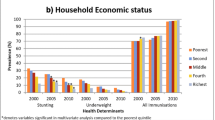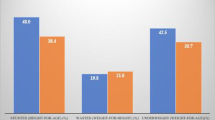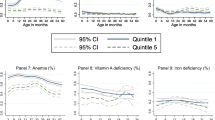Abstract
This study analyses variations in child health/nutritional status with socioeconomic status and other factors in Nigeria’s geopolitical zones using data from the Nigeria demographic and health surveys (NDHS) for 2003, 2008 and 2013. The study applies multivariate probit regression analysis and descriptive approaches on measures of child nutritional status such as height-for-age, weight-for-age and weight-for-height z-scores. The results indicate that child nutritional status varies significantly with individual and household socioeconomic and demographic characteristics. Overall, the study shows that higher household income, education level of mother above primary, availability of vitamin A supplement two months after delivery, and living in sanitary environment are significantly associated with lower probability of child poor nutritional status that may lead to stunting and underweight. The results also show that in Nigeria child poor nutritional status significantly decreased over time as captured by the year dummies. These findings vary substantially across the six geopolitical zones. The study therefore recommends that zonal-specific policy interventions are needed to improve child health in Nigeria.

Similar content being viewed by others
References
Abubakar, N., Atiku, M. K., Alhassan, A. J., Mohammed, I. Y., Garba, R. M., & Gwarzo, G. D. (2017). An assessment of micronutrient deficiency: A comparative study of children with protein-energy malnutrition and apparently healthy controls in Kano, Northern Nigeria. Tropical Journal Medical Research, 20, 61–65.
Adeyanju, O., Tubeuf, S., & Ensor, T. (2017). Socio-economic inequalities in access to maternal and child healthcare in Nigeria: changes over time and decomposition analysis. Health Policy and Planning, 32(8), 1111–1118. https://doi.org/10.1093/heapol/czx049.
Akombi, B. J., Agho, K. E., Merom, D., Renzaho, A. M., Hall, J. J., Wali, N., Renzaho, A. M. N., & Merom, D. (2017). Stunting, Wasting and Underweight in Sub-Saharan Africa: A Systematic Review. International Journal of Environmental Research and Public Health, 14(8), 863. https://doi.org/10.3390/ijerph14080863.
Alderman, H., Appleton, S., Haddad, L., Song, L., & Yohannes, Y. (2001). Reducing child malnutrition: How far does income growth take us? Centre for Research in economic development and international trade (CREDIT) research paper no 01/05.
Amaghionyeodiwe, L. A. (2008). Determinants of the choice of health care provider in Nigeria. Health Care Management Science, 11, 215–227.
Antai, D. (2011). Inequalities in under-5 mortality in Nigeria: Do ethnicity and socioeconomic position matter? J. Epidemiology, 21(1), 13–20.
Anyanwu, J.C. and Erhijakpor, A.E.O. (2009) Health Expenditures and Health Outcomes in Africa. Economic Research Working Paper. No. 91, African Development Bank.
Apenteng, B. A., Opoku, S. T., Ansong, D., Akowuah, E. A., & Afriyie-Gyawu, E. (2016). The effect of power outages on in-facility mortality in healthcare facilities: Evidence from Ghana. Global Public Health, 12(9), 1–12(9),11. https://doi.org/10.1080/17441692.2016.1217031.
Becker, G. S. (1965). A Theory of the Allocation of Time. The Economic Journal, 75, 493–517.
Becker, G. S. (1981). A treatise on the family. Cambridge: Harvard University Press.
Bhattacharya, J., & Currie, J. (2000). Youths at Nutritional Risk: Malnourished or Misnourished? Working paper 7686. Cambridge: National Bureau of Economic Research.
Corroon, M., Speizer, I. S., Fotso, J.-C., Akiode, A., Saad, A., Calhoun, L., & Irani, L. (2014). The role of gender empowerment on reproductive health outcomes in urban Nigeria. Maternal and Child Health J, 18(1), 307–315.
Eze, T. C., Okpala, C. S., & Ogbodo, J. C. (2014). Patterns of Inequality in Human Development Across Nigeria’s Six Geopolitical Zones. Developing Country Studies, 4(8), 97–101.
Grossman, M. (1972). On the concept of health capital and the demand for health. Journal of Political Economy, 80, 223–255.
Gustafsson-Wright, E., & van der Gaag, J. (2008). An analysis of Nigeria’s Health Sector by State: Recommendations for the Expansion of the Hygeia Community Health Plan. Amsterdam Institute for International Development (AIID) and Brookings Institution. August 2008.
Ibiwoye, A., & Adeleke, I. A. (2008). Does National Health Insurance Promote Access to Quality Health? Evidence from Nigeria. Geneva Pap., 33, 219–233.
Ichoku, H. E., & Fonta, W. M. (2006). The Distributional Analysis of Healthcare Financing in Nigeria: a Case Study of Enugu State Poverty and Economic Policy, PEP-NETWORK Working Paper, No. 2006–17. Canada: University of Laval.
Ichoku, H. E., & Fonta, W. M. (2009). Catastrophic Healthcare Financing and Poverty; Empirical Evidence from Nigeria. Journal of Social and Economic Development, 11(2), 1–16.
Ichoku, H. E., & Nwosu, E. O. (2011). Social Determinants and Dynamics of Health Inequality in Nigeria, Central Bank of Nigeria Economic and Financial Review, 49(3), 47–70.
van der Kam, S., Salse-Ubach, N., Roll, S., Swarthout, T., Gayton-Toyoshima, S., Jiya, N. M., et al. (2016). Effect of Short-Term Supplementation withReady-to-Use Therapeutic Food or Micronutrients forChildren after Illness for Prevention of Malnutrition: A Randomised Controlled Trial in Nigeria. PLoS Medicine, 13(2), e1001952. https://doi.org/10.1371/journal.pmed.1001952.
Kabo, I., Otolorin, E., Williams, E., Orobaton, N., Abdullahi, H., Sadauki, H., Abdulkarim, M., & Dele, A. (2016). Monitoring maternal and newborn health outcomes in Bauchi state, Nigeria: An evaluation of a standards-based quality improvement intervention. International Journal for Quality in Health Care, 28(5), 566–572.
Neff, R. A., Palmer, A. M., McKenzie, S. E., & Lawrence, R. S. (2009). Food systems and public health disparities. Journal of Hunger & Environmental Nutrition, 4(3–4), 282–314. https://doi.org/10.1080/19320240903337041.
Nigerian Health Review (NHR) (2006). Nigerian health review. Abuja: Federal Ministry of Health.
Nigerian Health Review (NHR) (2008). Nigeria health system assessment 2008. Abuja: Federal Ministry of Health.
Nriagu, J., Udofia, E. A., Ibanga, E., & Ebuk, G. (2016). Health risks associated with oil pollution in the Niger Delta, Nigeria. International Journal of Environmental Research and Public Health, 13(3), 346. https://doi.org/10.3390/ijerph13030346.
Nwosu, E. O., Urama, N. E., & Uruakpa, C. (2012). Determinants of antenatal care services utilisation in Nigeria. Developing Country. Studies, 2, 41–52.
O’Donnell, O., van Doorslaer, E., Wagstaff, A. and Lindelow, M. (2008). Analyzing health equity using household survey data: A guide to techniques and their implementation. World Bank Institute, Washington.
Okeke, E., Glick, P., Chari, A., Abubakar, I. S., Pitchforth, E., Exley, J., Bashir, U., Gu, K., & Onyejekwe, O. (2016). The effect of increasing the supply of skilled health providers on pregnancy and birth outcomes: Evidence from the midwives service scheme in Nigeria. BMC Health Services Research, 16, 425.
Omotor, D. G. (2009). Determinants of federal government health expenditures in nigeria. International. Journal of Economic Perspectives, 3, 5–18.
Onwujekwe, O., & Uzochukwu, B. (2005). Socio-economic and geographic differentials in costs and payment strategies for primary healthcare services in Southeast Nigeria. Health Policy, 71, 383–397.
Salardi, P. (2007). The estimation of the health functioning production function for Brazil. A paper prepared for the 2007 International Conference of the Capability Approach. Ideas Changing History. September 17–20, hosted by the New School University, New York City.
Strauss, J., & Thomas, D. (1995). Human Resources: Empirical modeling of household and family decisions. In J. Behrman & T. N. Srinivasan (Eds.), Handbook of Development Economics, Vol. 3. Amsterdam: North-Holland.
Wang, L. (2002). Determinants of child mortality in low-income countries: Empirical findings from demographic and health surveys. The Word Bank, Washington.
Weitzman, A. (2017). The effects of women's education on maternal health: Evidence from Peru. Social Science & Medicine, 180(2017), 1–9. https://doi.org/10.1016/j.socscimed.2017.03.004.
WHO (2000) The World Health Report 2000 - Health systems: improving performance.
World Health Organisation (WHO). (1995). Physical status: The use and interpretation of anthropometry. Report of a WHO expert committee. World Health Organization Technical Report Series, 854, 1–452.
World Health Organisation (WHO) (2006). WHO | Draft outline: World health report 2006. Retrieved 15 July 2012, from http://www.who.int/hrh/whr06_consultation/en/print.htm.
Author information
Authors and Affiliations
Corresponding author
Rights and permissions
About this article
Cite this article
Nwosu, E.O., Orji, A. A Comparative Analysis of Socioeconomic Indicators and Child Nutritional Status in Nigeria’s Geopolitical Zones. Child Ind Res 11, 1677–1698 (2018). https://doi.org/10.1007/s12187-017-9507-2
Accepted:
Published:
Issue Date:
DOI: https://doi.org/10.1007/s12187-017-9507-2





